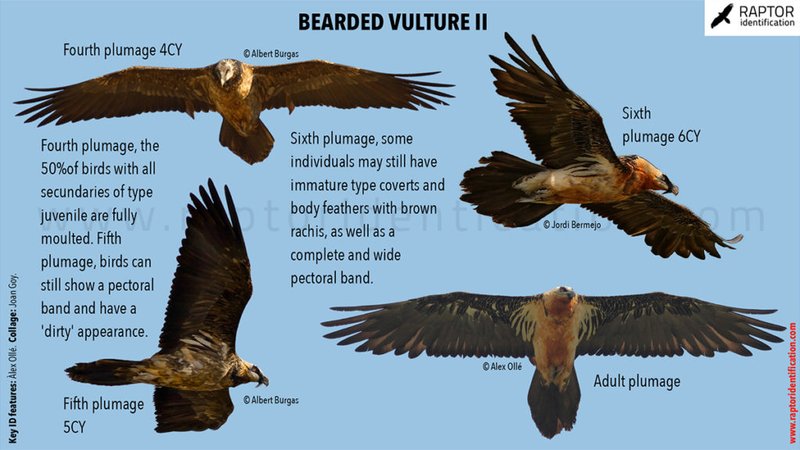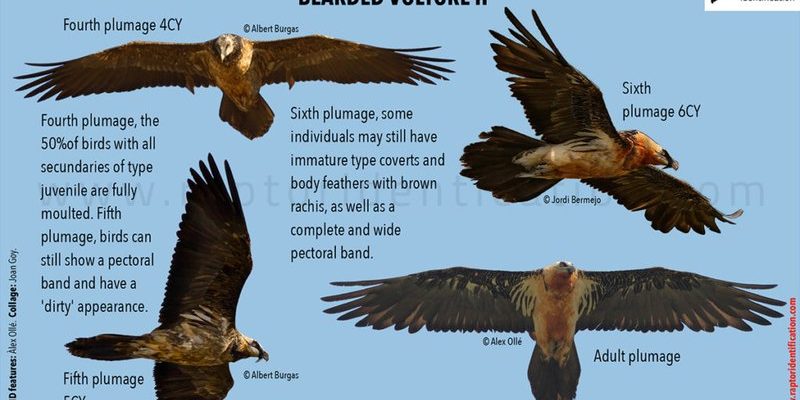
When you think of the bearded vulture, imagine a bird that balances both grace and impressive strength. They play an essential role in the ecosystem, and spotting one can be a rewarding experience for birdwatchers and nature lovers alike. So, grab your binoculars and let’s dive into how to recognize these remarkable birds!
Understanding the Bearded Vulture’s Unique Appearance
The bearded vulture is hard to miss, thanks to its distinctive looks. Adult birds have a wingspan that can reach over 9 feet. That’s larger than a lot of the common birds you see every day! Their feathers are primarily a rich rust color with a striking black and white head. It’s almost like they’re wearing a natural cloak, blending into the mountain terrains they often inhabit.
One of the most fascinating features of these birds is their “beard.” This unique tuft of black feathers beneath their beak gives them a rugged, wise appearance. Honestly, if you saw one up close, you might think they look like the ancient guardians of the mountains.
When watching for them, pay attention to their flight pattern. They glide effortlessly on thermal updrafts, seldom flapping their wings unless necessary. If you see a large bird soaring with ease, it’s worth checking if it might be a bearded vulture.
Habitat: Where to Look for Bearded Vultures
Bearded vultures prefer high, rocky regions. Think Alps, Himalayas, and Pyrenees. These areas provide the cliffs and open spaces they need to soar and nest. They often inhabit mountainous terrains, so if you’re in a national park or a nature reserve that features these landscapes, you’re in luck!
During the breeding season, they build their nests on ledges or rocky crags. If you’re trekking in these areas, look near cliff edges or steep mountain faces. Sometimes, you might even spot them near large animal carcasses, as they aren’t picky eaters—they’ll go for bones, thanks to their specialized digestive systems.
And don’t forget to check for signs. Sometimes, you can find feathers or even remnants of bones they’ve been feeding on. It can feel a bit like following a trail of clues in a mystery novel!
Behavioral Traits: What to Watch For
Watching a bearded vulture is not just about its appearance; it’s also about how it behaves. These birds are known for their impressive skills in manipulation. They often pick up bones and drop them from heights to break them open and access the nutritious marrow inside. This behavior is quite unique among birds.
If you see a vulture circling in the sky, keep an eye on what it’s doing. Are they diving down and climbing back up? That could mean they’re trying to crack open a bone. Their aerial antics are fascinating to observe and a big part of what makes them so interesting.
Also, be mindful of their social side. Bearded vultures are often seen in pairs or small groups, especially during the breeding season. If you spot one, it’s worth sticking around to see if another joins it. They often communicate with each other through a series of vocalizations, adding another layer to your birdwatching experience.
Understanding Their Diet and Feeding Habits
The bearded vulture is a bit of a specialist when it comes to food. Unlike other vultures that might scavenge a variety of meals, they primarily feast on bones. They have a unique approach to feeding that’s both intriguing and efficient.
You might be wondering, “Why bones?” Here’s the thing: their strong stomachs can digest bone matter, which most other birds can’t. This means they have a niche that allows them to thrive in environments where other scavengers might struggle. If you’re lucky enough to spot one in action, you may see them dropping bones from great heights—sometimes over 100 feet high—to break them open.
If you’re on a hiking trail and spot a bearded vulture circling a carcass, it’s a good indicator that they’re in their feeding mode. Just be respectful and keep your distance to let them enjoy their meal.
Tips for Spotting Bearded Vultures
Ready to hit the trails? Here are some handy tips for spotting bearded vultures in the wild:
- Timing is Everything: Early morning or late afternoon are ideal times as they are often more active.
- Bring Binoculars: A good pair of binoculars will enhance your chances of spotting them from a distance.
- Join Birdwatching Groups: Connecting with local birdwatching communities can increase your chances of spotting these majestic creatures.
- Be Patient: Sometimes, you’ll need to sit quietly and wait. The longer you observe, the more you’ll see.
- Know Their Calls: Familiarize yourself with their vocalizations. It can help alert you when one is nearby.
Remember, the goal is to enjoy the experience fully. Take your time, soak in the surroundings, and appreciate the beauty of nature.
Conservation Status and Why It Matters
Bearded vultures are considered vulnerable due to habitat loss and other human-related threats. Their numbers have been steadily declining, which is concerning not just for bird lovers but for the environment as a whole. These birds play a crucial role in their ecosystems as scavengers, helping to break down and recycle nutrients.
By learning how to identify a bearded vulture and encouraging others to do the same, you’re part of a larger movement to appreciate and protect these incredible creatures. Awareness is the first step to conservation. Supporting wildlife conservation efforts or participating in community initiatives can help ensure these magnificent birds continue to soar in our skies.
Identifying a bearded vulture in the wild can feel like discovering a hidden gem. With their striking appearance, unique behaviors, and fascinating feeding habits, these birds offer a magical experience for anyone willing to search for them.
So next time you find yourself in the mountains, look up! Be patient, enjoy the moment, and you might just get lucky. Remember, birdwatching is not only about seeing these creatures; it’s about connecting with nature. Embrace the adventure and take a step back to appreciate the wild beauty around you. Happy birdwatching!

